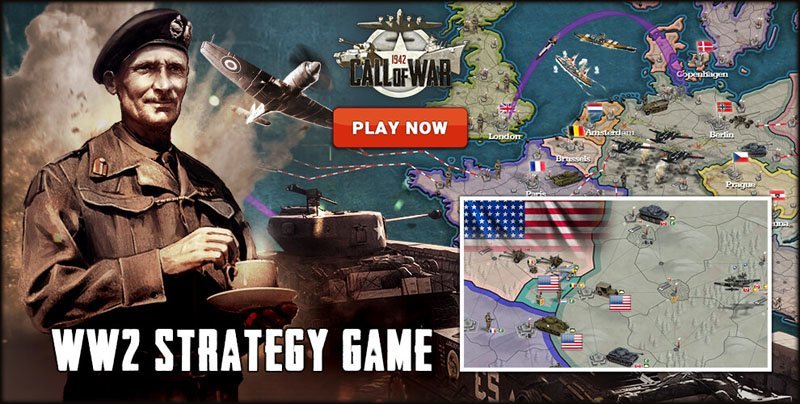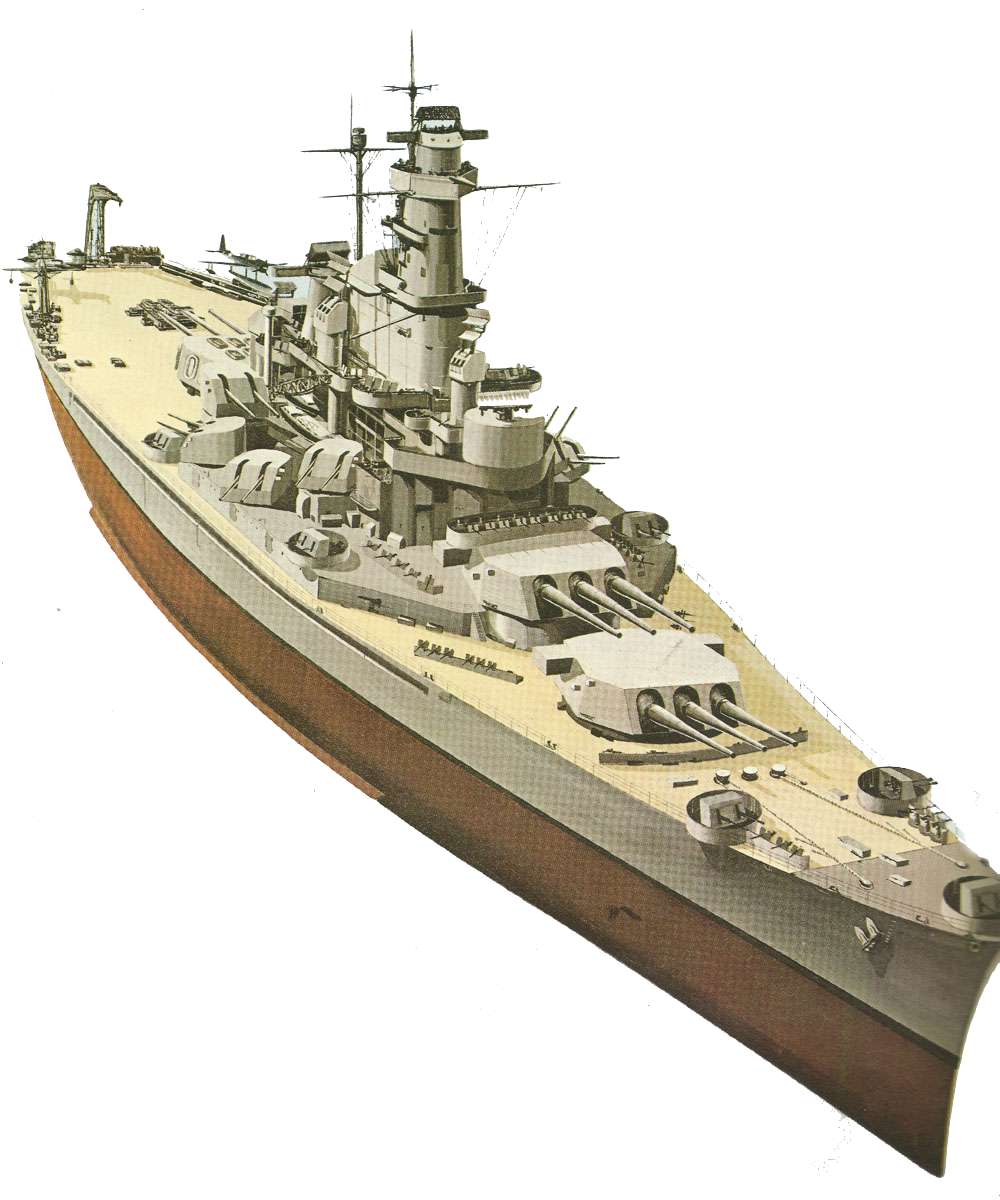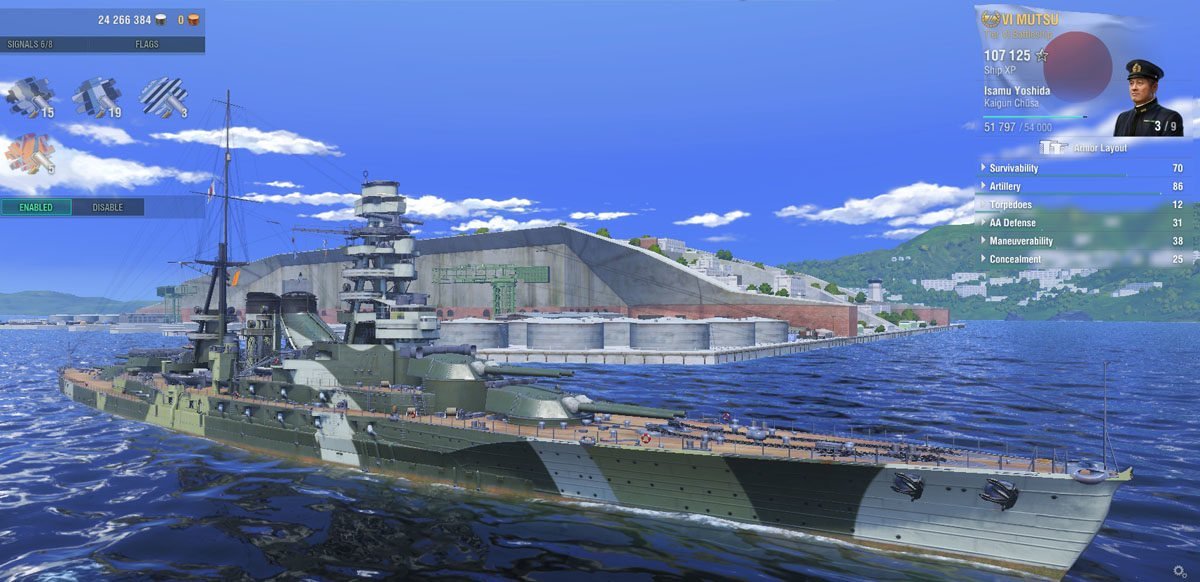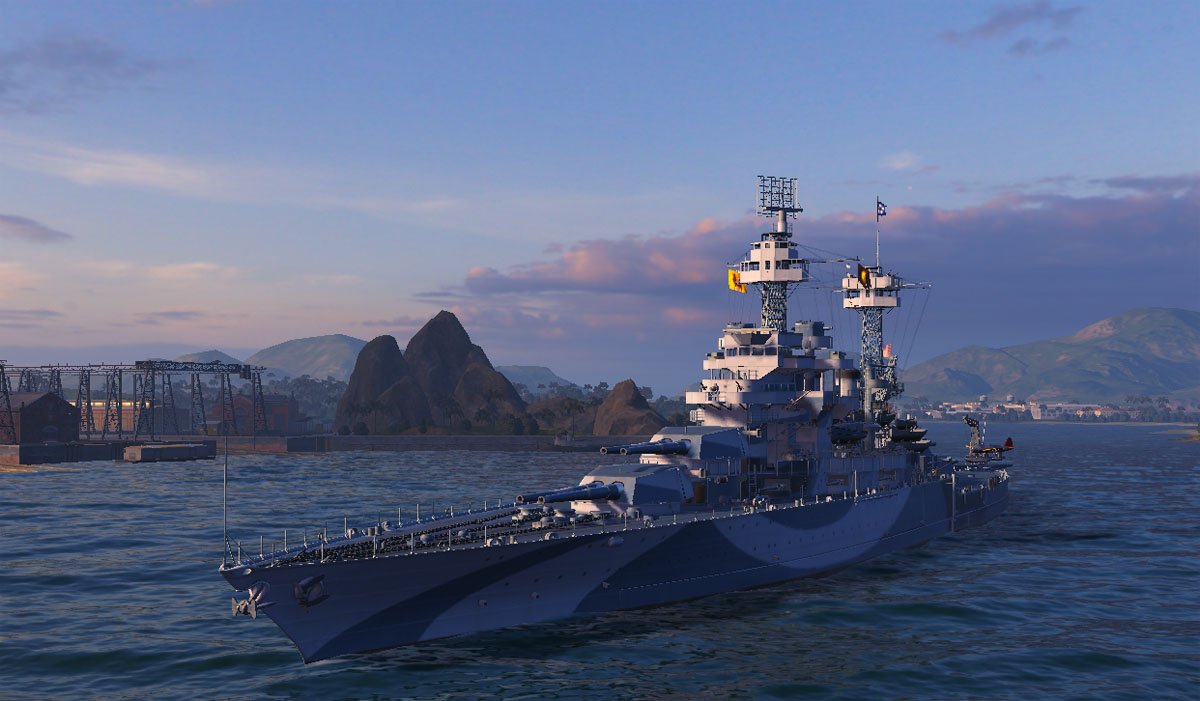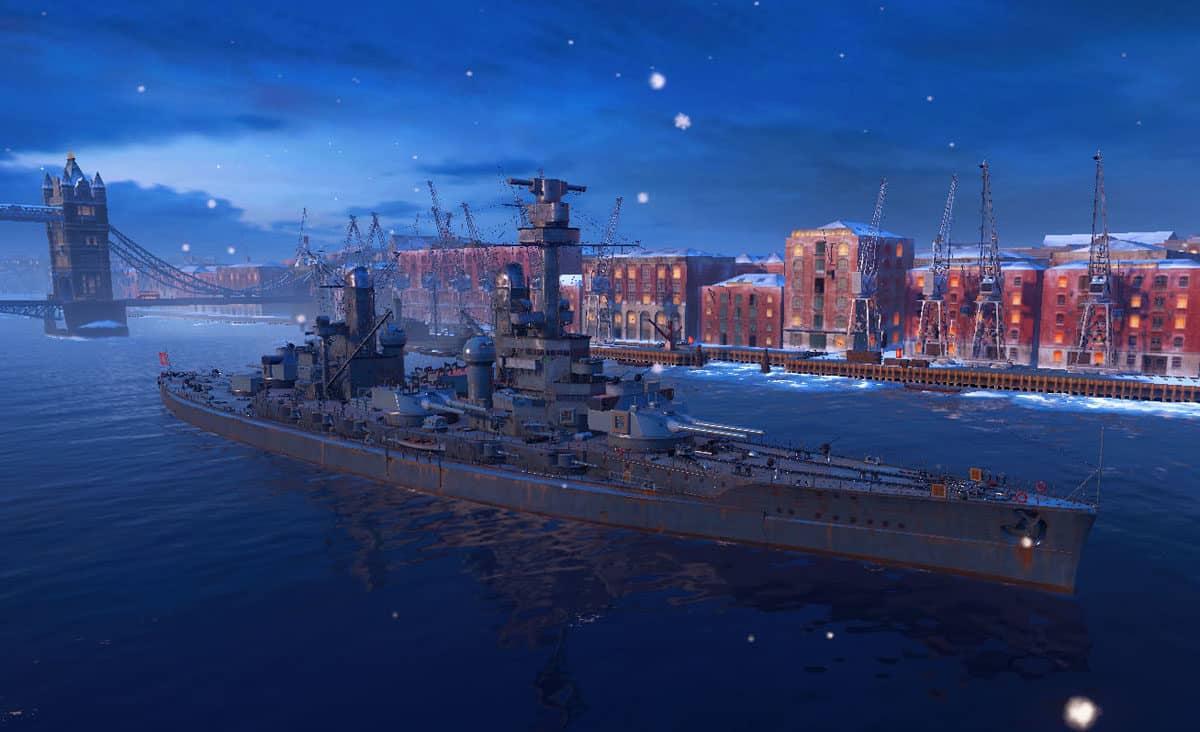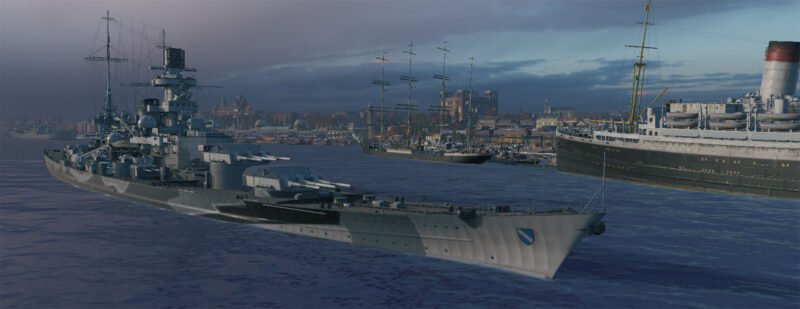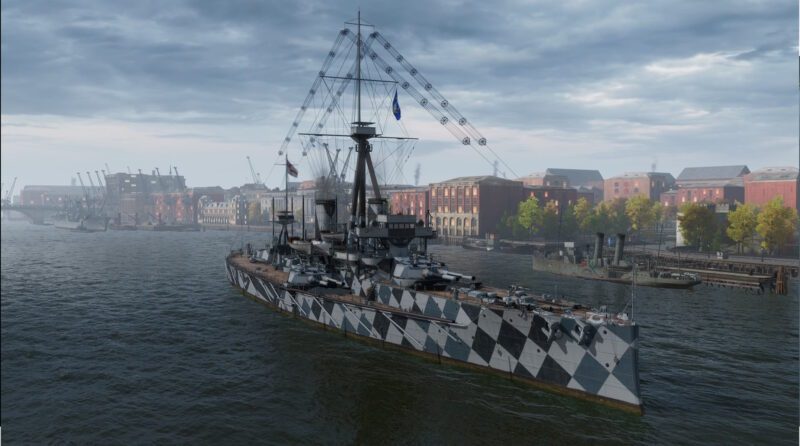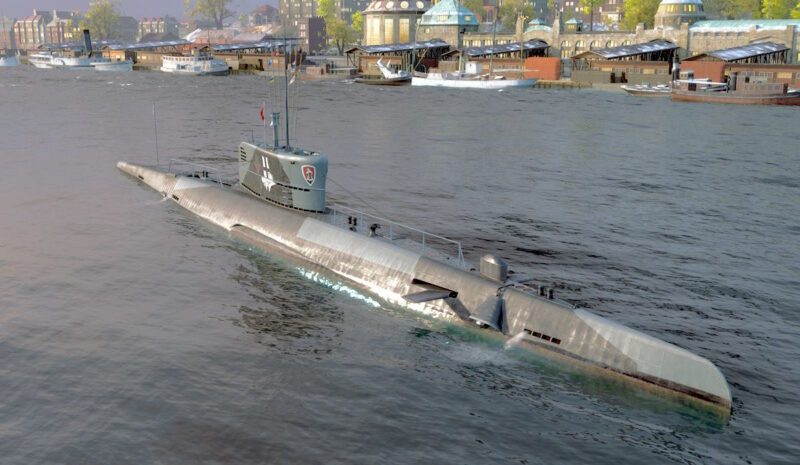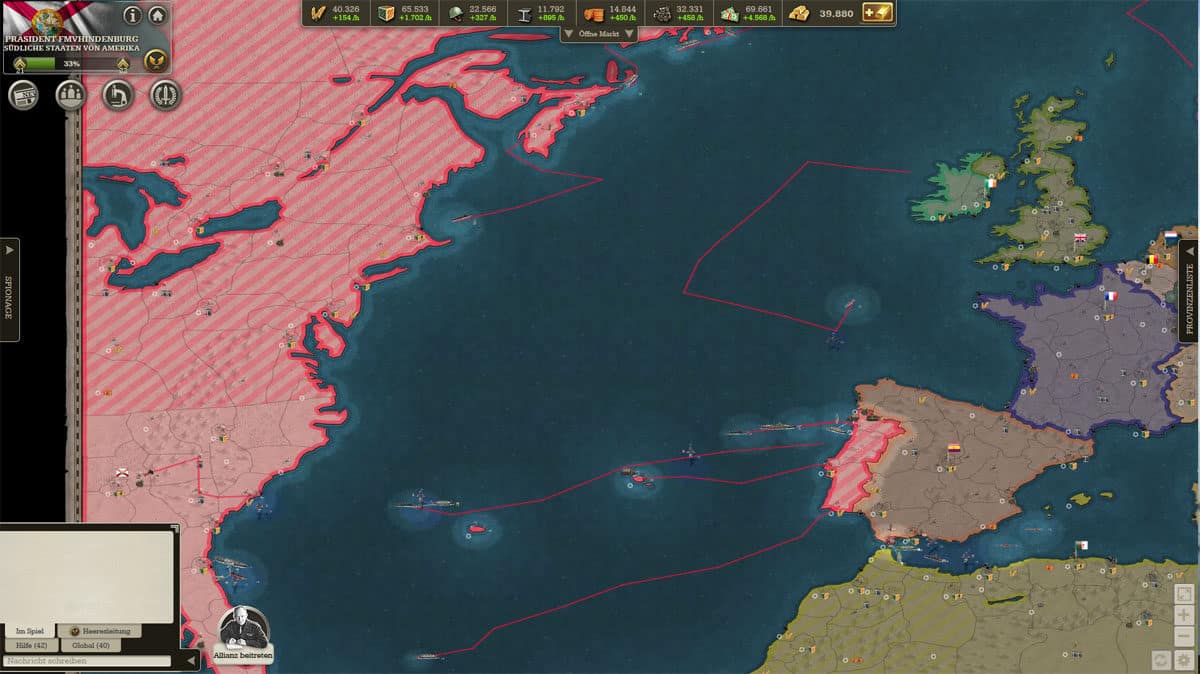History of the French battlecruiser Dunkerque and its proper use at World of Warships.
French battlecruisers Dunkerque and Strasbourg, built between 1932 and 1938, service, video and specifications.
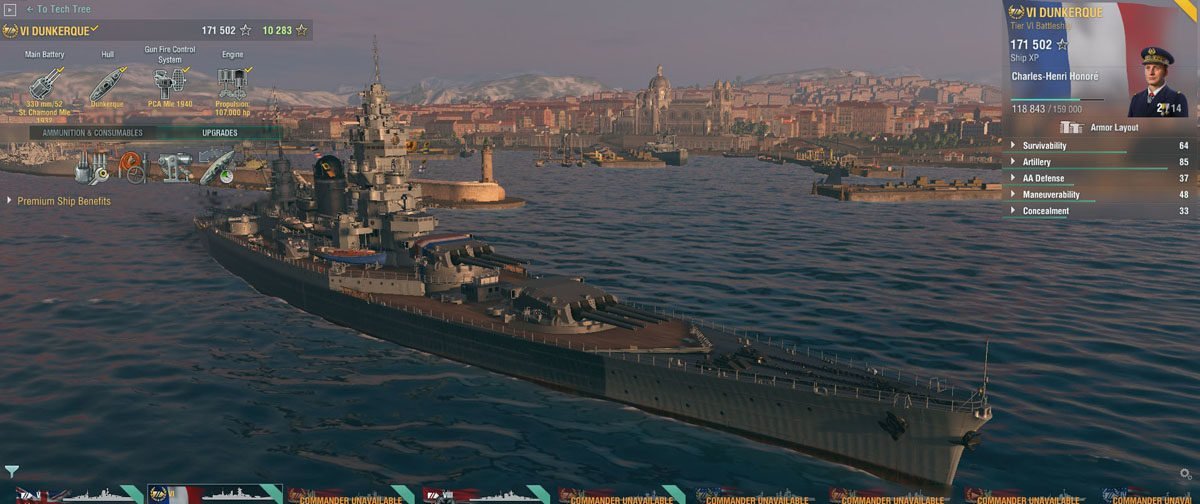
French fast battleships Dunkerque and Strasbourg
Table of Contents
Dunkerque, Strasbourg
Type: Battlecruiser.
The French battlecruisers Dunkerque and Strasbourg were actually classified as fast battleships rather than traditional battlecruisers, though their design and role shared some characteristics with battlecruisers of the interwar period. They were built in the late 1920s and early 1930s as part of France’s response to naval developments elsewhere, especially Germany’s Deutschland-class “pocket battleships.”
Background and Context
– After World War I, naval treaties such as the Washington Naval Treaty limited battleship size and armament, prompting navies to innovate within restrictions.
– France faced a particular threat from the German Deutschland-class ships, which were heavily armed and fast, but relatively lightly armored.
– The French Navy sought to build ships that could outgun the Deutschlands and outrun heavier battleships, resulting in the Dunkerque-class design.
Design and Characteristics
– Class: Dunkerque-class fast battleships (sometimes called battlecruisers due to their speed and armament balance)
– Ships: Dunkerque (commissioned 1937) and Strasbourg (commissioned 1938)
– Displacement: Approximately 26,500 tons standard, about 35,000 tons full load
– Dimensions: Length around 214 meters (703 feet)
– Speed: About 29.5 knots, quite fast for battleships of the era
– Armament: Main battery: 8 × 330 mm (13 inch) guns in two quadruple turrets, both positioned forward (a distinctive layout); Secondary battery: 16 × 130 mm (5.1 inch) guns; Anti-aircraft guns and torpedo tubes
– Armor: Designed with relatively heavy armor for protection against 11-inch shells, but less than contemporary battleships with 14-inch or larger guns. The armor scheme emphasized protection against the expected threat (Deutschland-class “pocket battleships”).
Operational History
– Both ships served with the French Navy during the early years of World War II.
– They were based primarily in the Mediterranean.
– After France’s armistice with Germany in 1940, the ships were part of the Vichy French fleet.
– Dunkerque was damaged during the British attack at Mers-el-Kébir in July 1940.
– Strasbourg escaped the attack and later joined the Allies after the Allied invasion of North Africa.
– Both ships had limited action during the war and were eventually scrapped post-war.
Significance
– The Dunkerque-class represented a unique French approach to balancing speed, firepower, and protection within treaty limits.
– Their design influenced later French battleships, such as the Richelieu-class.
– They were among the first battleships to mount their main armament entirely forward, a layout that saved weight and allowed a more compact armored citadel.
History
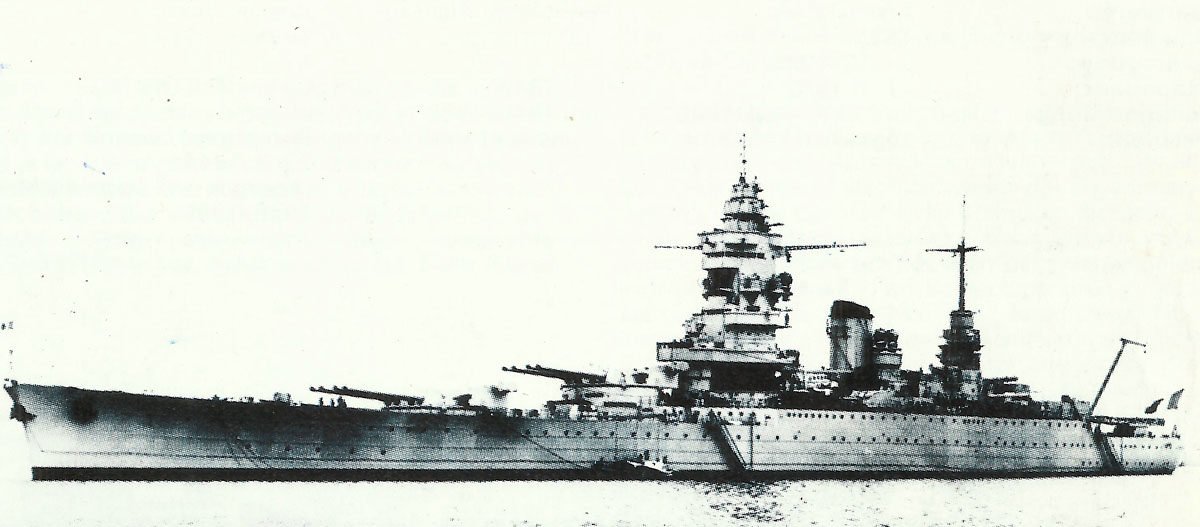
These French battlecruisers were built between 1932 and 1938. Since 1926 a replacement for the outdated Dreadnought battleships of the Courbet class was discussed, because according to the provisions of the Washington Fleet Treaty France was allowed to start building a new large battleship in 1927.
At that time, the naval staff preferred a Croiseur de Combat (light battlecruiser) and in January 1927 submitted a paper outlining a proposal for a ship that would resemble the later German pocket battleships. The ship should also be able to operate as a raider, while at the same time being fast enough to escape the contemporary battleships.
After the pocket battleships of the German class had actually appeared, the original French proposal was reconsidered. In addition, the British were now of the opinion that the displacement of large battleships should be limited to 25,000 tons, which led to major disagreements among the French over the suitable size for the new ship to be built.
A bilateral agreement was reached with the Italians that no more than two warships with a maximum of 35,000 tons each would be built for each of the two navies. This left the French and Italian navies with 70,000 tons each to build three or four more warships.
Under these circumstances, the Conseil Superieur de la Marine drew up plans for a 25,000 tons battlecruiser armed with eight 13-inch (330 mm) guns and with sufficient armor to withstand the 280 mm shells of the German pocket battleships.
To save weight, the eight main guns were to be mounted in two four-gun turrets at the front of the ship. This arrangement was already used on the British Nelson class battleships, but was planned by the French as early as 1914 for the Normandy class, which was later cancelled.
At the end of April 1932, the final plans were approved for a single ship known as a battleship Batiment de ligne, not as a battlecruiser Croiseur de Combat. When it became known that Mussolini had in the meantime ordered two new large battleships for the Italian Navy, funds were made available in July 1934 for the construction of another ship of the class.
The two battlecruisers Dunkerque and Strasbourg had a good speed, but their weak side armour made them second-rate class. This was evident in 1940 at Mers-el-Kebir, where the Dunkerque was pierced by British 15-inch (381 mm) shells. However, the ship survived the hits much better than expected.
The theoretical superiority of dual-function secondary armament was reduced by the inherent weakness of the 5.1-inch (130 mm) gun positions. In addition, the light anti-aircraft armament was particularly weak.
On the other hand its underwater protection was good and Dunkerque easily survived the hit of an 18-inch (46 cm) air torpedo like the detonations of several depth-charges bombs when an armed trawler exploded next to her.
The armor was internally inclined 210 degrees, with an inner ‘curvature’ and a layer filled with ebonite mousse, a thick black rubber similar to an old cellulose layer used on French ships in the 1890s.
The Model 1933 330 mm (13-inch) guns had a muzzle velocity of 2,625 ft/sec (800 meters per second) and could fire a 1,190 lb (540kg) shell 21,872 yards (20,000 metres) far. Each of the two quadruples basically consisted of two double turrets. This arrangement allowed the largest possible number of main artillery guns to be fired with minimum water displacement, but as was later shown at Mers-el-Kebir, the main artillery could be halved with a single direct hit.
By the arrangement of the two turrets on the fore deck the length of the belt armor could be shortened, but the two turrets must had to have enough distance, so that not both could be knocked-out already with a single hit. As with other types of ships with the main artillery arrangement after the bow, the smoke and muzzle pressure affected the forward firing more than to the side.
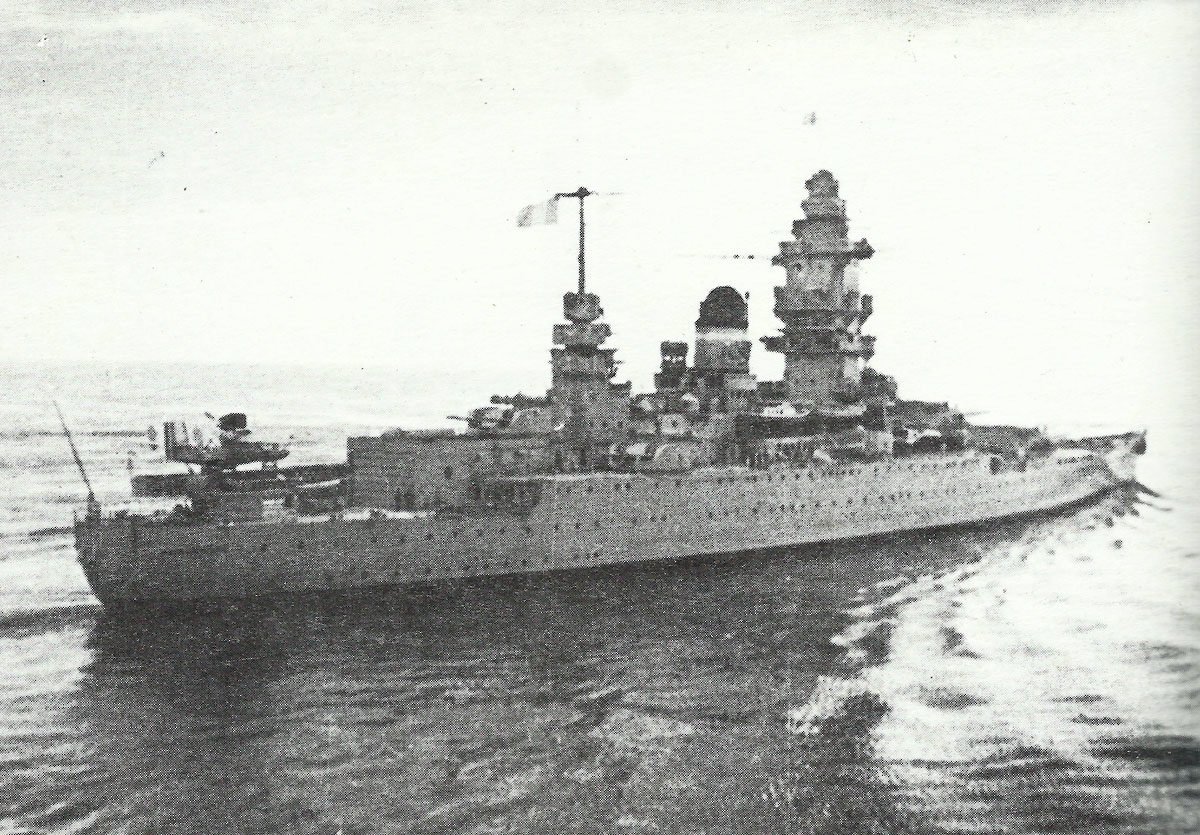
The Model 1935 130 mm (5.1-inch) secondary guns were in three quadruple positions and two twin positions and had the same muzzle velocity as the 330 mm main guns. They were able to fire a 71 lb (32.1 kg) shell at a distance of 21,653 yards (19,800 meters). Each of these barrels was theoretically capable of firing fourteen or fifteen rounds per minute. However, they moved too sluggishly for air defense purposes and their mechanics were also fragile.
The ships had an impressive engine power. Dunkerque made 30.57 knots in tests with 114,050 hp over eight hours and for two hours she even steamed with just over 31 knots at 135,585 hp. Her sister achieved slightly higher speeds in her tests and both were able to permanently maintain 20.5 knots with 25,000 hp or 28 knots with 28,000 hp.
At the stern there was a hangar for up to four reconnaissance planes. Overall, the ships were very well-balanced despite their new design and showed in practice that they could fulfil their intended purpose well.
Service
From 1938 to 1939 Dunkerque was in French home waters. From October 1939 to April 1940, the ship took part in the hunt for German raiders in the Atlantic, including the search for the Pocket-battleship Admiral Graf Spee. There were also escort duties for convoys. Afterwards Dunkerque and Strasbourg went to the Mediterranean.
The two ships lay on 3 July 1940 in Mers-el-Kebir near Oran, when the French fleet was attacked by the British Force H under Admiral Somerville at 16:56 hours.
The Dunkerque was hit while attempting to leave its anchorage and brought to a halt by four 15-inch (381 mm) shells. Although she fired 40 rounds at HMS Hood, her fire control was not accurate enough to hit and eventually the entire power system failed. Finally, she was able to drag herself under the cover fire of the Santon coastal artillery.
Two days later, Fairey Swordfish bombers from carrier HMS Ark Royal attacked and hit her with a torpedo, while Terre Neuve exploded at her side, causing further damage. A total of 150 were killed and 797 wounded on the battlecruiser.
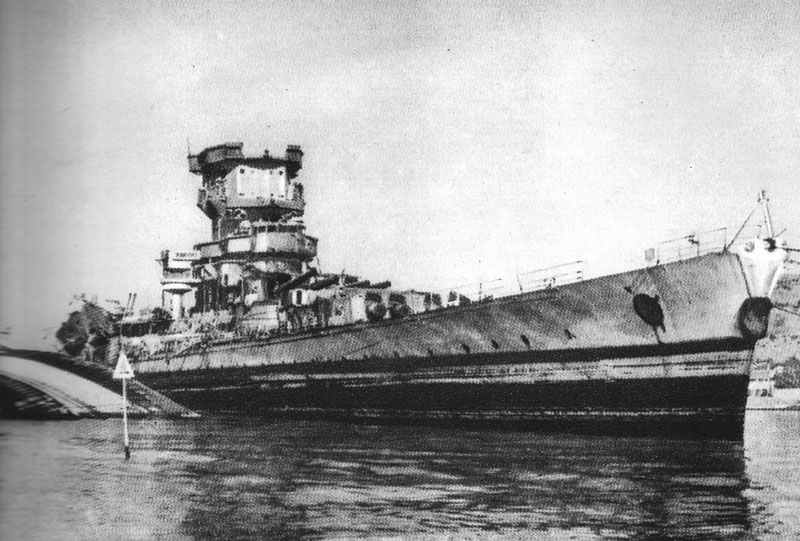
Strasbourg was more fortunate because it managed to be ready for action with the help of a smokescreen and was protected by the Santon guns until it was able to leave the port. On the way she was able to avoid three more attacks from torpedo bombers with her high speed.
She reached Toulon and later received her damaged sister ship. However, both ships were scuttled on 27 November 1942, when German troops stormed the arsenal to occupy the French fleet.
The hull of Strasbourg was lifted by an Italian salvage crew under General O Giannelli and in July 1943 was nominally taken over by the Italian Navy. Later confiscated by the Germans during the Italian surrender, it was again sunk by Allied bombing in August 1944.
When the French navy took over Toulon again in 1945, it was salvaged for the second time and used for various experiments with explosives and projectiles until it was scrapped in 1955.
User: France.
Dunkerque in WoWs
Status of the information: March 2019.
The French battlecruiser Dunkerque is also available as a premium ship in Free-To-Play Wargame World of Warships.
The ship is on Tier VI, as well as the already very good and freely available French battleship Normandy or the Japanese Mutsu and can be purchased for about 5,200 doubloons or Euros €20 at the Wargaming Shop. The author bought the Dunkerque at the last special offers on Christmas with a significant discount, so that the ship only cost him about 5 Euros.
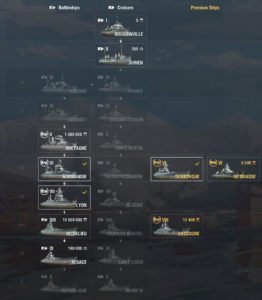
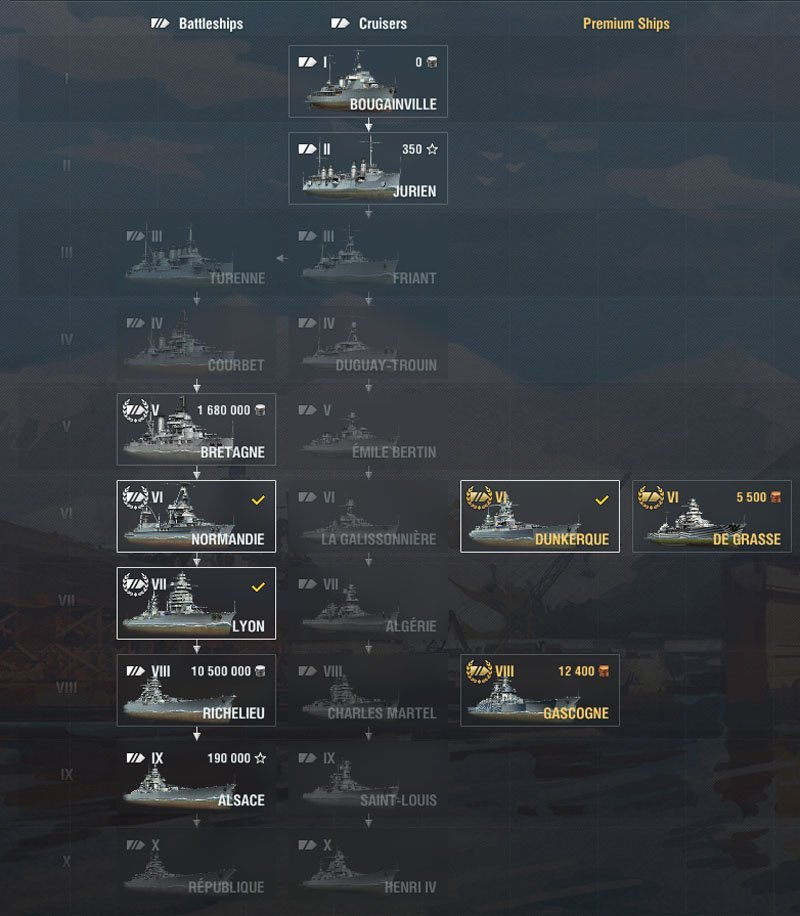
This ‘ridiculous price’ was possible because, in addition to the 20-25% discount on the actual purchase price at Christmas, World of Warships players, who had never bought anything from Wargaming after some time, also receive a special and limited special offer: If you buy a ship or any other product from the World of Warships shop, you also get free doubloons for three times the price!
As a new player to World of Warships, it is recommended that you wait for this special offer, which appears in the game’s port menu, before making any premium purchases.
As a premium ship, the Dunkerque offers several advantages over the freely playable standard ships of the research tree.
These include the fact that no modules have to be researched, because they are all available from the beginning. Furthermore, a premium ship brings more ‘credits’ per battle, which are needed for the purchase of new, researched ships, additional modules, etc.
At the same time more ‘free research points’ are earned, which can be invested in exploring any ship. It is also important that you can transfer any captain from ships of the same nation to the premium ship, where he will be promoted faster, without any cost or loss of experience. Last but not least, the ship also has a special camouflage paint, which brings advantages in combat and economy.
Dunkerque is for the author personally one of his most successful ships in World of Warships. After about 70 battles with more than 80 sunken ships there is a victory rate of 56% and more than two sinks for every loss of the Dunkerque !
The average performance of the Dunkerque players in World of Warships, however, is currently only about 0.83 sinks per battle and 1.3 sinks per loss with a victory rate of 52%.
This is why Dunkerque requires a very idiosyncratic playing style to be successful, as all eight main guns of the ship are mounted on the fore deck. These are very accurate, have a large firing range, which can be further increased by using reconnaissance planes.
The ship is also very sensitive to hits into the broadside, but most of the shells bounce off while on a direct course to the enemy at a slight angle. For this reason it is advisable to always aim with your bow directly at the enemy and to fire with the eight front main guns – at distances of over 10 kilometers with HE explosive shells and below with AP armor-piercing shells.
The advantage of this is also that most other battleships can fire with a comparable number of guns only when approaching with the broadside, whereby they must offer Dunkerque a sensitive target. Therefore, this French battlecruiser is usually superior in a battle against one or two enemies moving behind each other: by its larger number of guns on the fore deck and by the better armor protection at the bow, which leads to the rebound of many enemy shells.
However, the time of the attack with the Dunkerque is decisive. Because if other enemy ships can shoot Dunkerque into her broadside at this moment, the end is quickly foreseeable.
Therefore, at the beginning of the battle it is advisable to wait for the further course from the cover of an island and from there to fire enemy ships at a great distance with the help of the reconnaissance plane and explosive shells.
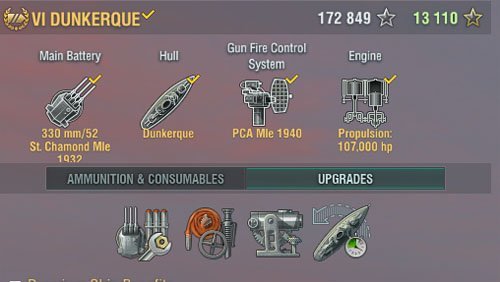
In order to be able to maneuver better on the islands and to avoid enemy torpedoes or artillery salvos when attacking later, it is recommended to install the ‘Steering Gear Modification 2’ at Dunkerque. Also, important is the ‘Main Armaments Modification 1’ module to minimize the risk of the turrets with the main guns behind the bow being out of action during the attack. Because if the main artillery in only two turrets fails or is completely switched off, your own attack can hardly be successful.
Therefore, Dunkerque is best equipped with modules in this order from left to right: Main Armaments Modification 1, Damage Control System Modification 1, Aiming System Modification 1 and Steering Gear Modification 2.
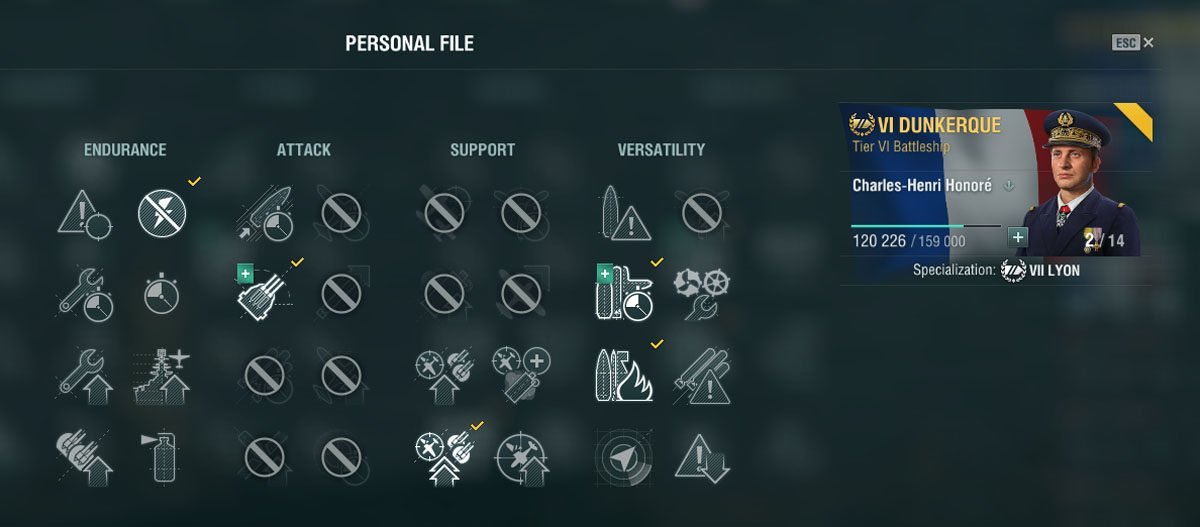
As captain for the Dunkerque, the author uses Charles-Henri Honore from the Arsenal with the following features: Preventive maintenance in row one, Expert Marksman and Adrenaline Rush in row two, Demolition Expert on row three, and Advanced Fire Training on four, which required upgrading from the original ten to twelve skill points.
The next four skill points are planned for Concealment Expert, so Dunkerque can’t continue to be discovered at such great distances from the enemy, which is one of their main drawbacks.

Video of an action with the battlecruiser Dunkerque in WoWs
Further information:
The player statistics for ships in World of Warships can be found here:
Warship Statistics.
The specifications and features of the Dunkerque in World of Warships are here:
Dunkerque – French Premium Tier VI battleship.
An alternative review about the Dunkerque can be found here:
Little White Mouse.
Specifications Dunkerque
Specifications:
Dunkerque | Specification |
|---|---|
Type | Battlecruiser |
Displacement (normal) | 30,750 tons |
Displacement (full load) | 31,400 tons |
Length at waterline | 686 ft (209.1 m) |
Length over everything | 703 ft 9 in (214.5 m) |
Beam | 101 ft 11 in (31.08 m) |
Draught | 31 ft 6 in (9.60 m) |
Boiler | 6 x Indret water tube boiler |
Machinery | Parson 4-shaft geared steam turbines |
Power | 112,500 - 114,000 hp |
Oil | 6,600 t |
Speed | 29.5 kts (max 30.57 kts) |
Range | 7,500 sm at 15 kts |
Crew | 1,381 |
Armament:
Dunkerque | Specification |
|---|---|
Main Armament | 8 x 13 inch (330 mm) L/52 guns |
Secondary Armament | 16 x 5.1 inch (130 mm) L/45 |
Anti-aircraft guns | 8 x 1.46 inch (37 mm); 32 x 13.2mm MGs |
Torpedo tubes | - |
Aircrafts | 4 |
Armour Protection:
Dunkerque | thickness |
|---|---|
Side (belt) | 145 - 245 mm |
Main deck | 138 mm |
Lower deck | 50 mm |
Main artillery | 254 - 330 mm |
Babette | 120 mm and 345 mm |
Secondary artillery | 80 - 90 mm |
Service Statistics:
Figures | Dunkerque | Strasbourg |
|---|---|---|
Laid down | 26 Dec 1932 | 25 Nov 1934 |
Launched | 2 Oct 1935 | 12 Dec 1936 |
Completed | 1 May 1937 | Dec 1938 |
Fate | heavy damage 27 Nov 1942; scrapped 1958 | scuttled 27 Nov 1942; scrapped 1955 |




